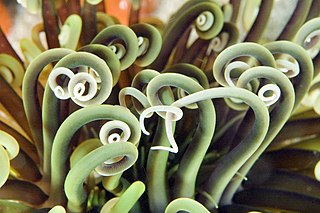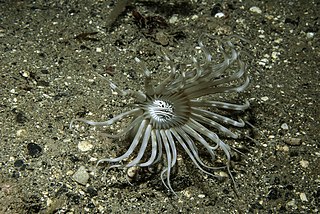
Actiniidae is the largest family of sea anemones, to which most common, temperate, shore species belong. Most members of this family do not participate in symbioses with fishes. Three exceptions are the bubble-tip anemone, snakelocks anemone and Urticina piscivora.

Tube-dwelling anemones or ceriantharians look very similar to sea anemones but belong to an entirely different class of anthozoans. They are solitary, living buried in soft sediments. Tube anemones live inside and can withdraw into tubes, which are composed of a fibrous material made from secreted mucus and threads of nematocyst-like organelles known as ptychocysts. Within the tubes of these ceriantharians, more than one polyp is present, which is an exceptional trait because species that create tube systems usually contain only one polyp per tube. Ceriantharians were formerly classified in the taxon Ceriantipatharia along with the black corals but have since been moved to their own class, Ceriantharia.

Sagartiidae is a family of sea anemones.

Anthothoe is a genus of sea anemones in the family Sagartiidae.

Bunodactis is a genus of sea anemones in the family Actiniidae.

Metridiidae is a family of sea anemones in the order Actiniaria.

Cerianthus is a genus of tube-dwelling anemones in the family Cerianthidae. Members of the genus are found worldwide. They are predators, scavengers and omnivores.

Edwardsiidae is a family of sea anemones. Edwardsiids have long thin bodies and live buried in sediments or in holes or crevices in rock.

Sagartiogeton is a genus of sea anemones in the family Sagartiidae.

Cerianthidae is a family of tube-dwelling anemones in the order Spirularia of the subclass Ceriantharia.
Ceriantheomorphe is a genus of tube-dwelling anemones in the family Cerianthidae.

Arachnanthus is a genus of tube-dwelling anemones in the family Arachnactidae. Members of the genus are found worldwide.

Actinostolidae is a family of sea anemones in the order Actiniaria. Members of this family are deep sea species, with some occurring at hydrothermal vents.

Actinostola is a genus of sea anemones in the order Actiniaria. All members of this genus are deep-sea species, with some occurring at hydrothermal vents.

Diadumene is a genus of sea anemones. It is the only genus in the monotypic family Diadumenidae.

Pachycerianthus is a genus of marine tube-dwelling anemones in the family Cerianthidae.
Bathyphelliidae is a family of sea anemones.
Boloceroididae is a family of sea anemones. It has a cosmopolitan distribution in tropical and temperate oceans.
Cerianthula is a genus of cnidarians belonging to the family Botrucnidiferidae.
Botrucnidiferidae is a family of cnidarians belonging to the order Spirularia.















